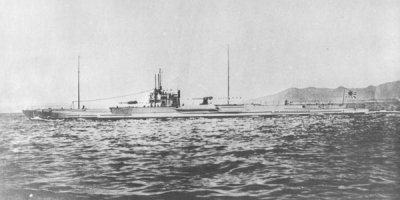![]() The Pacific War Online Encyclopedia
The Pacific War Online Encyclopedia
|
| Previous: I'chang | Table of Contents | Next: I-6, Japanese Submarine |

|
Tonnage |
2080 tons standard 2243 tons surfaced 2921 tons submerged |
|
Dimensions |
308'7" by 29'8" by 17'8" 94.06m by 9.04m by 5.38m |
|
Maximum speed |
18 knots (surfaced) 8 knots (submerged) |
| Dive | to 260 feet (79 meters) |
|
Complement |
68-93 |
|
Armament |
1 5.5"/50 gun 1 5"/40 dual-purpose gun 1 heavy machine gun 1 light machine gun 6 21" torpedo tubes (20 torpedoes) |
| Machinery |
2-shaft diesel (6000 bhp) or
electric (2600 hp) |
| Bunkerage | 548 tons diesel oil |
| Range | 24,000 nautical miles (44,000 km) at 10 knots surfaced 60 nautical miles (110 km) at 3 knots submerged |
The I-5 was an experimental
one-off development of the J1s (J1M class) that originally
included a catapult and two watertight deck tubes containing the
fuselage and wings of a seaplane.
The aircraft
had
to be
assembled from
the tubes while the submarine was surfaced, leaving the submarine
highly
vulnerable to attack. There was also no catapult for launching the
aircraft and the handling arrangements were unsatisfactory. However,
the Japanese believed the seaplane-equipped scouting submarine concept
had
great
promise.
The seaplane provisions were eliminated in 1940,
leaving the I-5 little
different from other J1s.
I-5 was deployed east of Oahu when war broke out, and was sunk on 19 July 1944 off Guam by Wyman.
References
Jentschura, Jung, and Mickel (1977)
CombinedFleet.com (accessed 2008-3-24)
The Pacific War Online Encyclopedia © 2007, 2009, 2012 by Kent G. Budge. Index